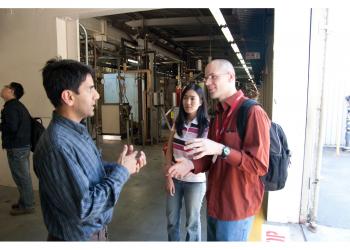September 19, 2011
Some 120 incoming and current Stanford graduate students last week enjoyed five days of presentations, discussions and networking activities relating to the wide range of energy research and teaching offered at Stanford and SLAC.
The first Energy@Stanford & SLAC conference featured more than 30 presentations on topics ranging from energy-conversion science and technologies to energy policies and commercial challenges. Many of the talks had two parts: one given by a professor, the other by a current graduate student. Attendees hailed from 19 departments across campus.
Tuesday afternoon the students came to SLAC to learn about research conducted by the Stanford Institute for Materials and Energy Sciences (SIMES) and to tour the SLAC site.
“Our goals are to show both incoming and current grad students the breadth of research going on at Stanford and SLAC and to help these students develop an interdisciplinary network of colleagues who are also interested in energy,” said Zhi-Xun Shen, SLAC chief scientist.
Key elements of the event were the nightly dinners, each located at a different site on Stanford’s property: Jasper Ridge Biological Preserve, SLAC, Graduate School of Business, Jen-Hsun Huang Engineering Center and the private home of Lynn Orr, professor of energy resources engineering.
“Most of the participants this year are incoming graduate students,” said Orr, director of the Stanford Precourt Institute for Energy (PIE). “Our goal is to give these new students an opportunity to experience the full spectrum of the Stanford energy universe – everything from cutting-edge solar cell technology to climate modeling to the psychology of energy efficiency and much more.
"We also hope to create links among students in lots of disciplines across the campus," Orr added. "Solving the world’s energy problems will require all their knowledge and skills.”
Attendees were impressed.
"I am amazed at the interdisciplinary thrust here at Stanford," said Hrishi R. Goel, a first-year master's student in management science and engineering. "In just a week, I got a taste of all the opportunities available in energy research across all fields – be it pure science, engineering, economics or policy. I would not have figured all this out on my own in a full year of taking courses."
“It’s wonderful to see all these brilliant students – new and more experienced grad students alike – connecting with each other and with professors," Shen added. "I believe it will have a lasting positive impact on their careers.”
The Energy@Stanford & SLAC conference is co-sponsored by PIE, SIMES, Global Climate & Energy Project (GCEP), SLAC National Accelerator Laboratory, National Renewable Energy Laboratory (NREL) and the Office of the Vice Provost of Graduate Education (VPGE).
The conference is part of the Stanford Summer Graduate Institute (SSGI), which consists of 11 non-credit, interdisciplinary conferences sponsored by VPGE. Most of this year’s SSGI events took place last week.
“These marvelous classes provide a unique opportunity for broad, cross-disciplinary exchange and making new connections across the entire Stanford graduate community,” states the SSGI website.

 SLAC National Accelerator Laboratory, Menlo Park, CA | Operated by Stanford University for the U.S. Dept. of Energy Office of Science
SLAC National Accelerator Laboratory, Menlo Park, CA | Operated by Stanford University for the U.S. Dept. of Energy Office of Science